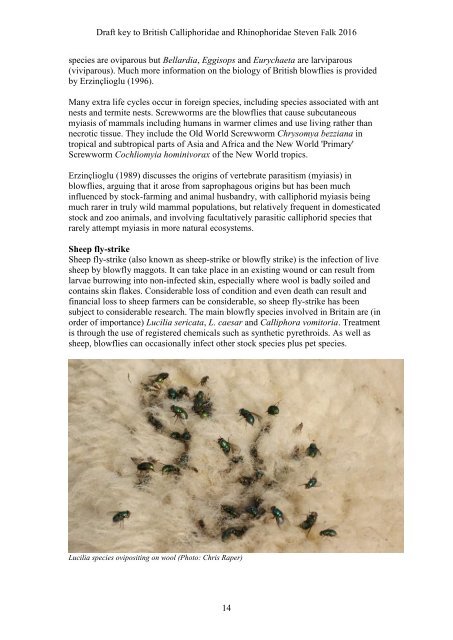BRITISH BLOWFLIES (CALLIPHORIDAE) AND WOODLOUSE FLIES (RHINOPHORIDAE)
4cmTmdCuA
4cmTmdCuA
Create successful ePaper yourself
Turn your PDF publications into a flip-book with our unique Google optimized e-Paper software.
Draft key to British Calliphoridae and Rhinophoridae Steven Falk 2016<br />
species are oviparous but Bellardia, Eggisops and Eurychaeta are larviparous<br />
(viviparous). Much more information on the biology of British blowflies is provided<br />
by Erzinçlioglu (1996).<br />
Many extra life cycles occur in foreign species, including species associated with ant<br />
nests and termite nests. Screwworms are the blowflies that cause subcutaneous<br />
myiasis of mammals including humans in warmer climes and use living rather than<br />
necrotic tissue. They include the Old World Screwworm Chrysomya bezziana in<br />
tropical and subtropical parts of Asia and Africa and the New World 'Primary'<br />
Screwworm Cochliomyia hominivorax of the New World tropics.<br />
Erzinçlioglu (1989) discusses the origins of vertebrate parasitism (myiasis) in<br />
blowflies, arguing that it arose from saprophagous origins but has been much<br />
influenced by stock-farming and animal husbandry, with calliphorid myiasis being<br />
much rarer in truly wild mammal populations, but relatively frequent in domesticated<br />
stock and zoo animals, and involving facultatively parasitic calliphorid species that<br />
rarely attempt myiasis in more natural ecosystems.<br />
Sheep fly-strike<br />
Sheep fly-strike (also known as sheep-strike or blowfly strike) is the infection of live<br />
sheep by blowfly maggots. It can take place in an existing wound or can result from<br />
larvae burrowing into non-infected skin, especially where wool is badly soiled and<br />
contains skin flakes. Considerable loss of condition and even death can result and<br />
financial loss to sheep farmers can be considerable, so sheep fly-strike has been<br />
subject to considerable research. The main blowfly species involved in Britain are (in<br />
order of importance) Lucilia sericata, L. caesar and Calliphora vomitoria. Treatment<br />
is through the use of registered chemicals such as synthetic pyrethroids. As well as<br />
sheep, blowflies can occasionally infect other stock species plus pet species.<br />
Lucilia species ovipositing on wool (Photo: Chris Raper)<br />
14


